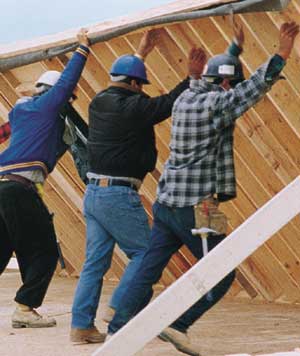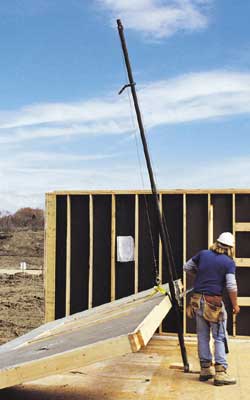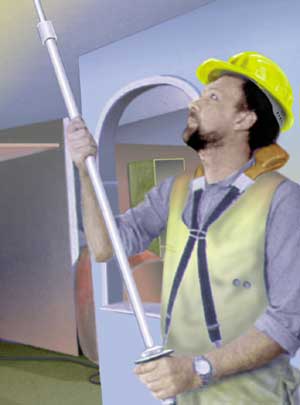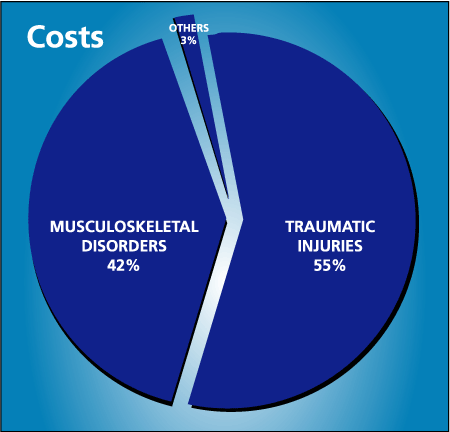Summary Statement
Describes the nature of musculoskeletal disorders, the incidence of them, the impact and methods to reduce them.
Autumn, 2000
What are the causes and controls in construction?
WHAT ARE MUSCULOSKELETAL DISORDERS?Musculoskeletal disorders (MSDs) are injuries of the muscles, nerves, tendons, ligaments, joints, cartilage, or spinal discs. MSDs are not typically the result of any instantaneous or acute event (such as a slip, trip, or fall) but reflect a more gradual or chronic development.
Other expressions used to describe MSDs include
- Repetitive Strain Injuries (RSIs)
- Cumulative Trauma Disorders
- Overuse Injuries
- Repetitive Motion Disorders.
Medical terms used to describe MSDs to various parts of the body include low back pain, tendentious, bursitis, carpal tunnel syndrome, epicondylitis, trigger finger, thoracic outlet syndrome, carpet layers' knee, and degenerative disc disease.
WHY ARE MSDs A PROBLEM?- MSDs may cause a great deal of pain and suffering among afflicted workers.
- MSDs are among the most common lost-time injuries. Over a five-year period, MSDs average approximately 45% of the total annual lost-time injuries in Ontario construction (see Figure 1).
- MSDs are among the most costly occupational problems. As shown in Figure 2, MSDs accounted over 41% of Workplace Safety and Insurance Board (WSIB) costs.
- Job activities that may cause MSDs span diverse workplaces and operations.
- MSDs may decrease productivity and the quality of products and services. Workers experiencing aches and pains on the job may not be able to do quality work.
WHAT RISK FACTORS CONTRIBUTE TO MSDs?
Figure 1: Percent of total lost-time injuries by type of occupational injuries and illnesses. Percent of total lost-time injuries is averaged across five years (1994-1998). Data obtained from the Workplace Safety and Insurance Board on June 30, 1999.
Figure 2: Percent of total WSIB costs by type of occupational injuries and illnesses. Total cost includes compensation and medical costs. Percent of costs is averaged across five years (1994-1998). Data obtained from the Workplace Safety and Insurance Board on June 30, 1999.
The following are recognized as important risk factors, especially when they occur at high levels and in combination.
1) Forceful
exertion - Force is the amount of effort required to perform a
task or job. The amount of force one can exert depends on one's posture
and the number of exertions performed. The more force that is exerted,
the greater the stress on the body. Lifting, pushing, pulling, and gripping
a tool are examples of activities that require exerting force or muscle
effort.
2) Repetitive
movements - Movements performed over and over are described as
repetitive movements. But a repetitive movement can also be an awkward
posture held for long periods of time. These movements can be of risk
to the worker because of continual stress placed on one body part without
sufficient muscle recovery time. Nailing a deck, screwing drywall, and
tying rebar are examples of repetitive tasks.
3) Awkward
postures - Postures are the positions of body parts. Unnatural
positions or awkward postures are those in which joints are held or moved
away from the body's natural position. The closer the joint is to its
end of range of motion (for instance, bending the back forward as far
as possible), the greater the stress placed on the soft tissues of that
joint, such as muscles, nerves, and tendons.
4) Secondary risk factors
- Contact pressure is any external pressure that is applied to soft tissues and puts stress on those tissues. Holding tools where handles press into parts of the hand or arm is an example of contact pressure.
- Vibration is a secondary risk factor which can cause damage to nerves and blood tissues as well as other soft tissues.
- Gloves can be a risk factor for musculoskeletal disorders if they do not fit properly or if they restrict movement of the fingers and hands.
- Temperature can also affect muscles. Cold temperatures increase the stress placed on soft tissues by reducing their range of motion and flexibility. Heat affects the work rest cycles required due to the increase in fatigue and the need for muscle recovery.
5) Combination effect Chance of injury increases when two or more MSD risk factors combine in one job. One factor alone is unlikely to cause a high risk of injury. For example, performing a forceful lift once places a worker at less risk than performing a forceful lift several times an hour.
HOW CAN MSDs BE CONTROLLED?Two approaches are widely accepted for controlling workplace ergonomic hazards.
Engineering Controls These are measures taken to modify the forcefulness, repetitiveness, awkwardness, vibration levels, physical pressures, or environmental extremes connected with a particular job. Engineering controls are the preferred approach in preventing MSDs. Examples include modifications of 1) the workstation layout, 2) selection and use of tools, 3) work materials, and 4) work methods.
Administrative Controls - Administrative controls are management-directed work practices and policies. Administrative control strategies include 1) changes in job rules and procedures such as scheduling more rest breaks, 2) rotating workers through jobs that are physically tiring, and 3) training workers to recognize ergonomic risk factors and to learn techniques for reducing stress and strain while performing their job.
Although engineering controls are preferred, administrative controls can be helpful as temporary measures until engineering controls can be implemented or when engineering controls are not technically feasible. Since administrative controls do not eliminate hazards, the necessary precautions and safeguards must be followed.
Interventions to control MSDs can range from the simple to the elaborate. Modifications to existing design can be costly, but in many circumstances the interventions can save time and money.
WHAT ARE SOME CONSTRUCTION CONTROLS?The following are examples of engineering and administrative controls aimed at reducing MSDs in construction.
Manual handling of tools and material
- Plan ahead to minimize material handling.
- Improve housekeeping to prevent trips and falls.
- Where available, order ready-mixed mortar to decrease repetitive shoveling and exposure to cement powder.
- Use carts, dollies, hoists, or other mechanical handling devices.
- Increase use of ladder hoists, gin poles, daisy chains, or cranes to move materials on or off roofs.
- Use chain falls, motorized buggies, carrying handles, or extension handles for carrying large or awkward materials like drywall.
- Break loads into smaller units. For instance, put cement in bags weighing less than 50 lb.
- Use shoulder pads when carrying loads on shoulders.
- Employ administrative controls such as ergonomics training, pre-job exercises, weight labeling of materials, and encouraging two-person lifts with heavy objects.


A wall jack can help reduce the risk of MSDs for small crews
Weight of materials and equipment
- Where possible, use materials or equipment lighter than traditional types--for example, lighter-weight concrete blocks and fiberglass ladders.
- Order or provide material such as sand and cement in bags lighter than 50 lb.
Hand tools
- Use handles that are comfortable and afford a good grip, such as rubber or spongy-type grips.
- Make sure grips are the right size for the hands and designed for use by either hand.
- Use hand tools designed with a power grip for heavy work and a pinch grip for fine work.
- Select hand tools designed to suit a neutral wrist posture and reduce the amount of force applied.
- Use tools that have torque reduction, low kickback, or lighter weight when appropriate.
- Ensure adequate power supply and proper maintenance of power tools.

Making the job a little easier: grip handle and head support
Vibration
- Use vibration-absorbing padding on grips or handles. Anti-vibration gloves or vibration-dampened handles are recommended on pavement breakers, tampers, torque wrenches, needle guns, and pad sanders.
- Provide regular maintenance and sharpening of tools.
- Use vibration-dampened seating, devices to dampen engine or motor vibration, and vibration-dampening flooring.
- Ensure proper tuning and balancing of engines and motors.
- Use cutting or powerhead vibration dampening devices.
- Isolate chassis.
- Purchase or rent equipment that includes vibration-dampening rubber grommets on controls and control box.
Overhead work
- Use drywall lifts, materials lifts, duct jacks, scissor lifts, and extension poles or stands for operating tools overhead.
- Reduce risks from awkward work postures by using adjustable scaffolds, aerial and other work platforms.
Work at ground or floor level
- Use tables, benches, or stands to bring work to waist height.
- Store materials at waist height.
- Introduce adjustable height scaffolds for bricklaying.
- Use pipe stands on pipe and steam fitting jobs, D-handles or longer handles for shoveling, rebar-tying devices, standup fastening systems for roof insulation, rug rippers, carpet stretchers, and pipe/conduit benders.
Awkward postures
- Rent or buy equipment that provides the best visibility so that operators don't have to lean forward, twist, turn, or assume other awkward positions in order to see.
- Obtain equipment with better cab design, adjustable seats, and ergonomically designed levers, pedals, and foot rests.
- Select equipment with wraparound windshields, multiple mirrors, and tinted windows.
Other controls
- Repetitive work: Use power tools, rest breaks, job rotation, and rebar-tying devices.
- Kneeling: Use kneepads, pants with kneepad pockets, and micro rest and stretch breaks.
- Standing on concrete: Use shoe inserts, sit/stand stools, bucket seats (convert a 5 gal bucket into a seat), floor mats, and rest breaks.
In Ontario construction, MSDs represent a large and expensive problem--45% of all lost-time injury claims and 42% of total claim costs. The major risk factors for MSDs are heavy manual material handling, repetitive tasks, and awkward work postures. As these factors increase in frequency and duration, a worker's risk of incurring an MSD rises.
Province-wide, the construction industry faces an aging workforce and a shortage of trained workers. These conditions--combined with a high rate of musculoskeletal disorders, steep WSIB costs, and the medical burden to workers--can reduce production volume and quality.
With its industry partners--labour, management, government, manufacturers and suppliers--CSAO is working to reduce the risk of MSDs in Ontario construction.




